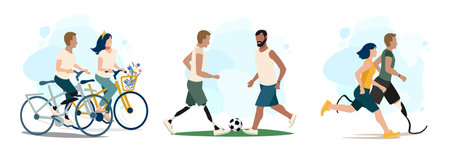Understanding Sports-Related Pain in Athletes
For athletes, pain is often a part of the game, but not all pain is created equal. Knowing the difference between types of sports injuries and how they affect performance is key to effective rehabilitation and prevention.
Common Causes of Pain in Athletes
Athletes can experience pain for many reasons, from pushing their bodies to the limit during training to suffering an unexpected fall or collision. Here are some of the most common causes:
| Cause | Description | Examples |
|---|---|---|
| Overuse | Repeated stress on muscles, tendons, or joints without enough rest | Tendonitis, stress fractures, shin splints |
| Traumatic Injury | A sudden event causing immediate damage | Ankle sprains, ACL tears, fractures |
| Poor Technique or Equipment | Using improper form or unsuitable gear increases injury risk | Back pain from poor lifting technique, blisters from ill-fitting shoes |
| Lack of Conditioning | Insufficient strength or flexibility leads to vulnerability | Muscle strains, joint instability |
Differentiating Acute and Chronic Sports Injuries
Sports-related pain usually falls into two categories: acute or chronic. Understanding the difference helps guide treatment and return-to-play decisions.
| Type of Injury | Description | Typical Examples |
|---|---|---|
| Acute Injury | Sudden onset, usually linked to a specific incident. Pain is immediate and often severe. | Sprained ankle from landing awkwardly, dislocated shoulder during a tackle |
| Chronic Injury | Develops over time due to repeated stress or overuse. Pain is gradual and can worsen if not treated. | Tennis elbow from repetitive motion, runner’s knee from long-term running without rest |
The Impact of Pain on Athletic Performance
Pain doesn’t just sideline athletes physically—it can also affect focus, confidence, and motivation. Even mild discomfort can alter movement patterns, leading to compensation injuries and longer recovery times. Addressing pain early with the right physical therapy strategies keeps athletes playing safely and at their best.
2. Initial Assessment and Pain Evaluation
Best Practices for Injury Evaluation
When an athlete comes in with a sports-related injury, the first step is to gather a detailed history. Ask about how the injury happened, what movements make the pain worse, and if they have any previous injuries. This helps guide your assessment and treatment plan.
Key Questions to Ask
| Question | Purpose |
|---|---|
| How did the injury occur? | Understand the mechanism of injury |
| When did the pain start? | Identify acute vs. chronic issues |
| What activities make it better or worse? | Determine aggravating/alleviating factors |
| Have you had similar injuries before? | Check for recurring problems |
| Do you feel numbness or tingling? | Screen for nerve involvement |
Clinical Assessment Techniques
A thorough physical exam follows the history. This usually includes:
- Observation: Look for swelling, bruising, or deformity.
- Palpation: Gently press on the area to find tender spots or unusual lumps.
- Range of Motion (ROM): Check how far the joint moves compared to the other side.
- Strength Testing: Assess muscle strength and identify any weaknesses.
- Functional Tests: Have athletes perform sport-specific movements to see what hurts or feels unstable.
Identifying Red Flags for Medical Referral
Certain signs mean it’s time to stop and refer the athlete to a doctor right away. These “red flags” can indicate more serious conditions that need immediate attention. Here’s a quick reference guide:
| Red Flag Symptom | Possible Concern | Action Needed |
|---|---|---|
| Numbness or tingling spreading down arms/legs | Nerve damage or spinal injury | Refer to MD immediately |
| Losing control of bladder/bowel function | Nerve compression (cauda equina syndrome) | Emergency medical referral |
| Unusual swelling with severe pain after trauma | Possible fracture or compartment syndrome | X-ray and MD evaluation needed ASAP |
| Catching, locking, or giving way in a joint with pain and swelling | Ligament tear or meniscus injury requiring imaging/surgical consults | Refer to orthopedic specialist |
The Importance of Early and Accurate Evaluation
A careful initial assessment sets the stage for effective recovery. By asking the right questions, using hands-on tests, and knowing when to seek further help, physical therapists can help athletes get back in the game safely and quickly.

3. Physical Therapy Approaches and Evidence-Based Interventions
When it comes to helping athletes recover from sports-related injuries, physical therapists use a combination of hands-on techniques, technology-based treatments, and movement-focused exercises. These approaches are tailored to the athlete’s specific sport, injury, and recovery goals. Let’s break down some of the most effective PT strategies used in the United States today.
Manual Therapy: Hands-On Healing
Manual therapy is a core part of sports rehab in the US. This approach includes techniques like joint mobilization, soft tissue massage, and stretching. The main goal is to reduce pain, improve range of motion, and speed up healing. For example, a PT may use deep tissue massage for muscle strains or gentle mobilization for sprained joints.
Modalities: Technology-Driven Relief
Physical therapists often use different modalities—tools and machines—to help manage pain and inflammation in athletes. Here’s a quick overview:
| Modality | How It Helps | Common Uses |
|---|---|---|
| Ice/Heat Therapy | Reduces swelling or relaxes muscles | Acute injuries, muscle tightness |
| Electrical Stimulation (E-stim) | Decreases pain signals and stimulates muscles | Knee injuries, muscle weakness |
| Ultrasound Therapy | Promotes tissue healing with sound waves | Ligament sprains, tendonitis |
| Kinesiology Taping | Supports injured areas without restricting movement | Ankle sprains, shoulder injuries |
Movement-Based Interventions: Getting Back in the Game
Athletes need targeted exercises to rebuild strength, flexibility, and coordination. PTs design personalized exercise programs that mimic sport-specific movements and gradually increase in intensity. These can include:
- Strength Training: Focused on rebuilding muscles around an injured area (like quad exercises after ACL injuries).
- Plyometrics: Jumping or explosive movements to retrain power and agility for sports like basketball or soccer.
- Balance Drills: Essential for preventing re-injury—think single-leg stands or wobble board activities.
- Functional Movement Training: Exercises that simulate real game situations, such as cutting or pivoting drills for football players.
Pain Management Tips Athletes Use With Their PTs
- Ice packs after intense sessions to reduce soreness.
- Taping techniques for added support during practice.
- Banded stretching routines to maintain flexibility.
- Guided breathing or relaxation strategies to manage stress-induced pain flare-ups.
The Importance of Sport-Specific Rehab Plans
No two athletes or injuries are exactly alike. That’s why American PTs customize treatment plans based on the demands of each sport—whether it’s running, throwing, or jumping. By using evidence-based interventions and tracking progress closely, physical therapists help athletes safely return to play stronger than before.
4. Integrating Rehab with Return-to-Play Protocols
The Importance of Progressive Rehabilitation
When athletes get injured, physical therapists (PTs) play a vital role in helping them recover and safely return to their sport. A key part of this process is progressive rehabilitation. This means starting with gentle exercises and gradually increasing intensity as the athlete heals. It’s not just about fixing the injury—it’s about making sure the body can handle the demands of the sport again.
| Rehab Phase | Main Focus | Example Activities |
|---|---|---|
| Early Stage | Pain control, gentle movement | Ice packs, range-of-motion exercises |
| Mid Stage | Building strength and flexibility | Resistance bands, stretching |
| Late Stage | Sport-specific skills, power, agility | Agility ladders, plyometrics, drills |
Incorporating Sport-Specific Drills
As healing progresses, PTs introduce drills that mimic movements from the athlete’s sport. For example, a basketball player might work on jumping and lateral movements, while a baseball pitcher practices throwing motions. These drills help athletes regain confidence and test their readiness in real-life scenarios.
Why Sport-Specific Drills Matter:
- Reduce risk of re-injury by preparing the body for actual game moves
- Build mental confidence in returning to play
- Smooth transition from rehab to full participation in practice or games
Collaborating with Coaches for Safe Reintegration
Athlete recovery is a team effort. PTs regularly communicate with coaches to ensure everyone is on the same page regarding an athlete’s progress. This collaboration helps create a smooth path back to play—balancing eagerness to return with necessary caution.
Key Ways PTs Work with Coaches:
- Share updates about rehab milestones and restrictions
- Create modified practice plans if needed (like non-contact drills)
- Monitor workload and watch for warning signs of overuse or pain recurrence
- Educate athletes and coaches about proper warm-ups and cooldowns to prevent future injuries
This integrated approach not only addresses pain but also builds a foundation for long-term athletic success and health.
5. Patient Education and Pain Management Strategies
Empowering Athletes Through Knowledge
Education is a powerful tool in helping athletes understand and manage their pain. By giving athletes the right information, physical therapists can help them make informed decisions about their recovery and daily activities. In the U.S., it’s common to encourage open conversations between athletes, coaches, and healthcare providers. This team approach builds trust and helps athletes feel supported throughout their journey.
Culturally Relevant Pain Coping Skills
In American sports culture, mental toughness is valued, but it’s important to balance this with smart pain management. Here are a few strategies:
- Mindfulness & Relaxation: Techniques like deep breathing, meditation, or guided imagery can help athletes cope with discomfort and reduce stress.
- Positive Self-Talk: Encouraging phrases such as “I’m getting stronger every day” can help athletes stay motivated during rehab.
- Social Support: Leaning on teammates, friends, family, or support groups helps create a sense of community and accountability.
Practical Tips for Injury Prevention
Athletes can take proactive steps to avoid injuries by following simple guidelines. Here’s a quick reference table:
| Prevention Tip | Description |
|---|---|
| Warm-Up Properly | Start every session with dynamic stretches and light cardio to prepare muscles and joints. |
| Use Correct Form | Focus on technique rather than just performance; ask for feedback from coaches or PTs. |
| Listen to Your Body | Pain is a signal—rest when needed and don’t push through severe discomfort. |
| Stay Hydrated & Eat Well | A balanced diet and proper hydration support recovery and overall health. |
| Cross-Train | Mix up workouts to avoid overuse injuries by engaging different muscle groups. |
Physical & Mental Empowerment Strategies
Physical Approaches
- Create a personalized home exercise plan that fits the athlete’s schedule.
- Set short-term goals (e.g., “walk pain-free for 10 minutes”) to track progress easily.
- Encourage regular check-ins with PTs for ongoing guidance and adjustments.
Mental Wellness Tips
- Practice gratitude journaling to focus on achievements rather than setbacks.
- Seek professional counseling if pain leads to anxiety or low mood—it’s okay to ask for help.
- Join online forums or local groups where athletes share experiences and advice.
The Big Picture: Athlete Independence
The goal is to empower athletes so they feel confident managing discomfort both physically and mentally. With culturally aware education, practical tools, and continuous support, athletes can return to their sport stronger and more resilient than before.


